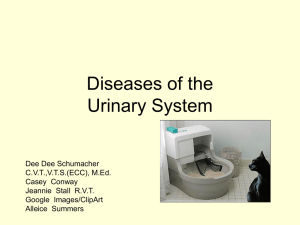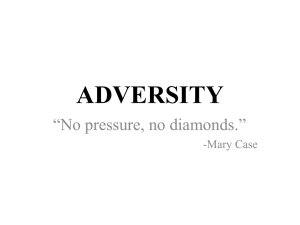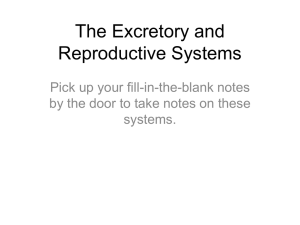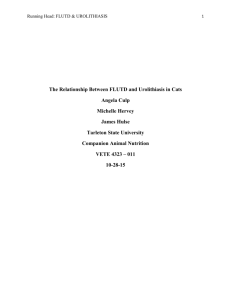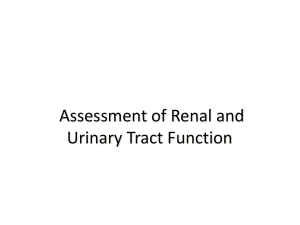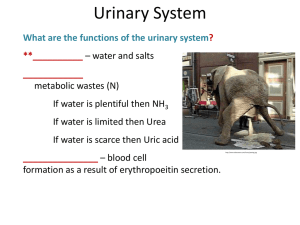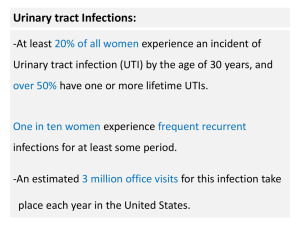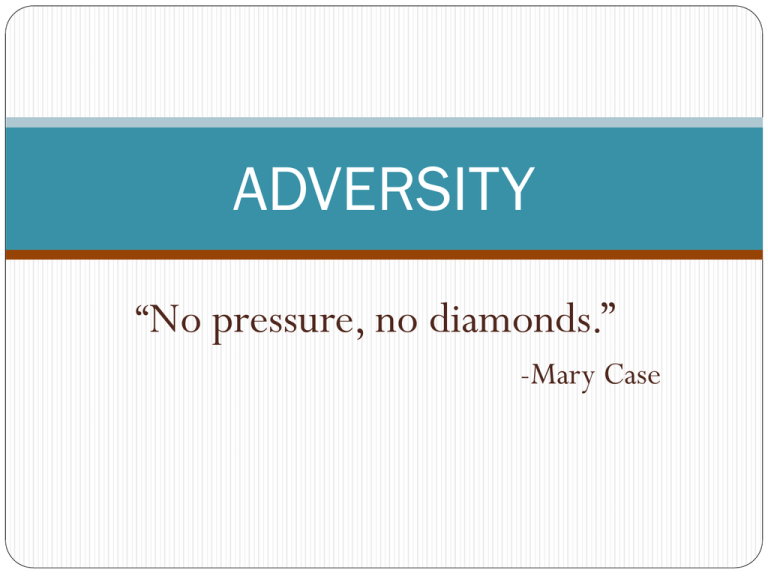
ADVERSITY
“No pressure, no diamonds.”
-Mary Case
DISEASES OF THE URINARY SYSTEM
Cystitis
Cystic calculi
Urinary obstruction
ARF & CRF
Incontinence
BLOOD FLOW THROUGH THE KIDNEYS
Renal arteriole > glomerulus > bowman’s capsule >
proximal convoluted tubule > loop of Henle >
ELIMINATED: distal convoluted tubule > collecting ducts
> renal pelvis > urine
COMPONENTS OF THE URINARY SYSTEM
and ITS FUNCTIONS
Functions of the kidneys
Excretion:
produce urine
Maintain homeostasis
Blood filtration, reabsorption, secretion
Fluid balance regulation
Acid-base balance regulation
Hormone production
DISEASES OF THE URINARY SYSTEM
URINARY SYSTEM IS NORMALLY STERILE
AND RESISTANT TO BACTERIAL
INFECTION
Voiding of urine
Urethral/ureteral peristalsis
Glycosaminoglycans in the surface mucosal
layer
pH
RECOGNIZING URINARY SYSTEM
DISORDERS
About 4 million cats a year are destroyed for
“elimination problems”.
DIAGNOSING URINARY SYSTEM
DISORDERS
DIAGNOSTIC TESTS THAT MAY BE DONE IN PATIENTS
WITH URINARY DISEASE
URINALYSIS (dipstick and sediment exam)
RADIOGRAPHS
DISEASES OF THE URINARY SYSTEM
Cystitis
Cystic calculi
Urinary obstruction
ARF & CRF
Incontinence
Feline Idiopathic (Interstitial) Cystitis
aka FUS/ FLUTD
FACTS:
-Occurs in cats 2-6 yrs old
-Occurrence in males > females
-cause unknown, multi-factorial
-not caused by bacterial infection
-recurrence is likely
Feline Idiopathic (Interstitial) Cystitis
Clinical Signs
pollakiuria
Hematuria
Dysuria
Periuria (sinks, tubs, carpet, etc.)
Feline Idiopathic (Interstitial) Cystitis
Diagnostics
Urinalysis/culture to r/o bacteria as cause
Only 1%-3% of all feline cystitis is caused by
bacteria
Radiographs to r/o calculi;
contrast studies may show thickened bladder wall
Feline Idiopathic (Interstitial) Cystitis
Treatment
Avoid unnecessary antibiotics
Change diet from dry to moist
Or salt food to ↑ water intake
Reduce stress from other cats, kids, etc
Provide hiding places
Pheromonotherapy
Behavior modification drugs (may also have pain reducing
effects
Amitryptilline (tri-cyclic antidepressant)
Clomipramine
Glycosaminoglycan replacement
Cosequin for cats
Adequan
Feline Idiopathic (Interstitial) Cystitis
Client info
Disease is self-limiting
As many as 85% of cats will have resolution of
clinical signs in 7-10 days
May be recurring problem
No definitive cure
Reduce stress
Canine Bacterial Cystitis
Cause: Ascending bacteria
up the urethra
Signs
↑ frequency of urination
Hematuria
Dysuria
Cloudy urine, abnormal
color
Frequent licking of
vaginal/urethral area
Canine Bacterial Cystitis
Diagnostics
Urinalysis:
↑WBC’s, bacteria
Common bacteria:
E.coli, Proteus spp.
Urine
culture/sensitivity
Collect by
cystocentesis or midstream collection
Canine Bacterial Cystitis
Treatment
Antibiotics according to sensitivity
Treat acute infections x 10-14 d
Subsequent infections x 4-6 w
Avoid trauma to urinary tract during surgery
Patients needing indwelling catheters should
have a closed system
Closed Urinary Catheter System
Canine Bacterial Cystitis
Client info
Many uncomplicated urinary
tract infections resolve without
Rx
Give antibiotics as directed for
the time prescribed
Relapses are common due to
inadequate treatment
Prostate may be source of
recurring infections in male
dogs
Urine cultures should be
repeated during treatment to
assess effect
DISEASES OF THE URINARY SYSTEM
Cystitis
Cystic calculi
Urinary obstruction
ARF & CRF
Incontinence
Feline Uroliths and Urethral Plugs
“Plugged” or “Blocked” male
cats are commonly seen in
small animal practice and can
be fatal if not relieved
Feline Uroliths & Urethral Plugs
The two most common causes of urethral
blockage are uroliths and urethral plugs
UROLITHS: composed of minerals and a
small amount of matrix
URETHRAL PLUGS: composed of small
amount of minerals and large amount of
matrix
Feline Uroliths and Urethral Plugs
• Signs
– Hematuria
– Dysuria
– Periuria
– Anorexia, vomiting
– Collapse, death
• Non-specific signs:
– Hiding
– Crying while urinating
– Frequent trips to the
litterbox
Feline Uroliths and Urethral Plugs
Uroliths (bladder stones)
found anywhere in urinary
tract
Formed from minerals in
diet
Some are radiopaque (Ca++
oxalate, urate, struvite) and
can be seen on x-ray
Some are radiolucent
(cystine) and require double
contrast
Pneumocystogram
Feline Uroliths and Urethral Plugs
Uroliths damage bladder, making it more
susceptible to bacterial infection, hematuria
Uroliths can cause blockage of the urethra
of males
Bladder will fill with urine
Kidneys will stop working
Blood/body will become toxic (azotemic)
Feline Uroliths and Urethral plugs
Feline Uroliths and Urethral Plugs
• Dx
Palpation of bladder
• Obstructed bladders are full and tight
Radiographs may show uroliths on routine films
Ultrasonography can locate position of urolith
Urolith analysis is necessary to determine its constituents
EKG: atrial standstill, bradycardia, hyperkalemia
Feline Uroliths and Urethral Plugs
Normal double-contrast cystogram
Double-contrast cystogram
with stones
pneumocystogram
Ultrasound of bladder stone
Feline Uroliths and Urethral Plugs
Treatment
Medical treatment (chronic, non-obstructed)
Dissolve struvite uroliths (most common- ~60%) by
acidifying urine and feeding diet low in Mg (Hill’s S/D,
c/d, others)
Should resolve in 4-8 wk
Re-radiograph, and continue diet 1 mo after uroliths gone
Cystotomy to remove stones
Antibiotics according to culture/sensitivity
Feline Uroliths and Urethral Plugs
Feline Uroliths and Urethral Plugs
Medical treatment (obstructed)
This is a medical emergency
Anesthetize (short acting)
*USE LESS ANESTHESIA IN AZOTEMIC CATS*
Pass Tom cat catheter and back flush
Sew catheter in place for 1-3 d, using a closed
system
Feline Uroliths and Urethral Plugs
Closed Urinary Catheter System
Feline Uroliths and Urethral Plugs
Surgical treatment (chronic obstructers)
Perineal urethrostomy (PU)
New opening for urethra is created proximal to
narrowing
Urethral opening looks similar to female
anatomy
*Goal of surgery is to decrease the likelihood of
life-threatening obstruction*
Feline Uroliths and Urethral Plugs:
Perineal Urethrostomy
Feline Uroliths and Urethral Plugs:
Perineal Urethrostomy
Canine Urolithiasis
Os Penis
Canine Urolithiasis
Uroliths damage mucosa of urinary tract making it
susceptible to infection
Uroliths can obstruct urine flow in males
Clinical Signs
pollakiuria
Dysuria
Hematuria
Canine Urolithiasis
Dx
Urinalysis
Crystalluria
Hematuria
↑ bacteria
Radiographs
Canine Urolithiasis
Canine Uroliths
Urolith
Breed
Sex
Contributing factors
Struvite
min sch
cats
female (80%)
alkaline urine
(Mg Ammonium Phos)
bacteria→urease→↑pH
minerals (diet)
Rx
acidify urine
antibiotics
Only Hill’s s/d (dissolve)
↓protein (ammonia)
↑H2O intake (flush stones)
acidy urine
Calcium Oxalate
(30-50% of
all stones)
Urates
cats
min sch
Lhasa, Yorkie
min poodle
Shih Tzu
Dalmatians
E bulldogs
min schnauzer
Shih Tzu
Yorkshire terrier
males
males
diet high in protein
hypercalcemia
Cushing’s Dis
use of cortisone
acid urine
↑ uric acid from kidneys
acid urine
Sx removal (only Rx)
↓ dietary Ca
Hill’s u/d, w/d, k/d
Allopurinol
(gout in humans)
+
K Citrate (↑ urine pH)
Hill’s u/d,
Canine Uroliths
Struvite
Calcium Oxalate
Type of stone cannot be determined by appearance; chemical analysis is required
Urate
Urolithiasis (Canine)
• Treatment
Medical (dissolve stones if Struvite)
• diet
• Acidify urine
– Urinary acidifiers (methionine, Methogel)
• ↑ urine output
– Add salt to diet, increase water intake
Antibiotics for bacterial infection
Surgical removal ( Ca Oxalate)
• Some uroliths are not amenable to Medical Rx
• However, the cause of uroliths must be dealt with medically (prevention)
• STONE ANALYSIS ISVITAL FOR APPROPRIATE TREATMENT
Cystotomy
Canine Urolithiasis: Cystotomy for stone
removal
Canine Urolithiasis
What do you see? How many?
Canine Urolithiasis
What do you see?
Flush toward bladder (8 times)
Saline flush
One in bladder, 2 in urethra
Canine Urolithiasis
What do you see?
Canine Urolithiasis
Client info
Special diet may be required for life-time
Table scraps/treats should be limited
Long-term antibiotics may be required
Uroliths may recur at any time
Always provide plenty of fresh water
Allow plenty of bathroom time and frequency
EDUCATION
“It is possible to store the mind with a
million facts and still be entirely
uneducated.”
- Alec Bourne
DISEASES OF THE URINARY SYSTEM
Cystitis
Cystic calculi
Urinary obstruction
ARF & CRF
Incontinence
Renal Failure
~20% of Cardiac output
Filtered by renal corpuscle
Reabsorbed by kidney
tubules
Waste excreted as urine
Renal Failure due to:
↓ blood flow
(hypoperfusion)
Damage to nephron and
glomerular filtration
declines resulting in
azotemia
AZOTEMIA
Pre-renal
dehydration
Renal
Primary kidney disorders
Post-renal
Urinary tract obstruction
Acute Renal Failure
Three distinct phases:
Induction: the time from the initial insult until
decreased renal function is apparent (hours to days)
Maintenance: the time period during which renal
tubular damage occurs (weeks to months)
Recovery: the time during which renal function
improves, existing nephrons hypertrophy and
compensate for those damaged, and tubular repair
occurs (when possible)
Stages of Kidney disease
Loss of Renal Reserve - Early signs of PU/PD
PU= polyuria (increased urination)
PD= polydipsia (increased drinking)
Renal Insufficiency - Early warning signs,
such as increased thirst, may begin to
appear
Renal Failure (Azotemia) - Kidneys cannot
eliminate waste efficiently, causing signs of
illness
Advanced Kidney Failure (Uremia) - Severe
signs of illness appear; eventually, collapse and
death result
Acute Renal Failure
An abrupt decrease in glomerular filtration →azotemia
Causes
Damage to nephron
Nephrotoxic drugs
Aminoglycosides (gentamicin, streptomycin)
Chemotherapeutic agents
Antifungal medications
Analgesics (acetaminophen)
Anesthetics (methoxyflurane [Metafane])
Ethylene glycol (antifreeze)
Acute Renal Failure
Causes:
Infections (pyelonephritis)
Immune-mediated diseases
(Glomerulonephritis)
Metabolic: Hypercalcemia
↓ Renal perfusion
Shock
Hypovolemia/dehydration
Hypotension
Acute Renal Failure
Signs (non-specific)
Kidneys are enlarged and painful on palpation
Signs of azotemia
Anorexia, dehydrated
Vomiting/diarrhea
Weakness
Fever
Acute Renal Failure
Dx
Urinalysis
urine sediment - casts
low sp gravity (unable to concentrate urine)
CBC
dehydration (↑PCV)
acidosis
Chem panel
↑ BUN, Creatinine
↑K+, Phosphorus
Acute Renal Failure
Tx (aim is to restore renal
hemodynamics)
Relieve tubular obstruction
Discontinue any toxic drugs
IV fluids
Correct dehydration
Correct acid/base imbalance
Acute Renal Failure
Client info
Renal function may never be like it was before
injury
Prognosis is guarded especially with older pets
Care must be taken to avoid events that may
precipitate further damage to kidney
Appropriate diet
Adequate water access
Chronic Renal Failure
Common in older pets;
cats appear to be
more affected than
dogs
Irreversible and
progressive decline in
renal function
(nephron damage)
Dogs > 8 yrs
Cats > 10 yrs
Chronic Renal Failure
Progressive
1st function lost: Ability to concentrate urine
PU, PD, nocturia
Loss of ADH response
Other functions lost: Ability to cleanse
blood
Azotemia (toxemia)
Begins at ~75% of nephron loss
↑ BUN, Creatinine
Anemia: erythropoietin secreted by kidneys
Chronic Renal Failure
Signs
Dull, lethargic, weak
Anorexia, wt loss
PU/PD, cervical ventroflexion
hypokalemia
• protein matrix (Tamm-Horsfall
mucoprotein)
that makes up the hyaline cast (hyaline
with fat)
• particulate material from degenerating
cells
• is present within the cast matrix
(hyaline to finely granular cast).
Chronic Renal Failure
Dx
Acidosis
Anemia
↑ BUN, Creatinine
increased phosphorus
Hypokalemia
Proteinuria
Chronic Renal Failure
Tx
Fluids for dehydration (IV, SQ)
Potassium gluconate, calcium carbonate for
electrolyte imbalances
Phosphorous binders: Aluminum hydroxide
Sodium bicarbonate for pH adjustment
Hormones
Epoetin
Vit B supplements
Chronic Renal Failure
Client info
CRF is progressive and irreversible
Rx is aimed at slowing its progress
SQ fluids at home are required to maintain
hydration
Warm foods to improve palatability
Quality of life will decrease; euthanasia may
have to be considered
ARF
(large size)
Inc.
CRF
(small size)
Dec.
Azotemia: Bun
and Creatine
Phosphorous
Inc.
Inc.
Inc.
Inc.
Potassium
Inc.
Dec.
PCV
Other
Acidosis,
proteinuria
DISEASES OF THE URINARY SYSTEM
Cystitis
Cystic calculi
Urinary obstruction
ARF & CRF
Incontinence
Urinary Incontinence
Loss of voluntary control of micturition
Causes
Neurogenic—loss of normal neural function causing a paralyzed
bladder
Ectopic ureters
Patent urachus
Endocrine imbalance (after spay)
Urinary Incontinence
Signs
Urine leakage when pet is sleeping or exercising
Perianal area of pet is always wet
Concurrent urinary tract infection
Dx
Urinalysis
X-rays/cystography
Chem panel to r/o PU from endocrine disease
Urinary Incontinence
Rx (based on specific cause)
Surgical correction
Endocrine deficiency in spayed female
Diethylstilbestrol (PO or inj)
Phenylpropanolamine (PROIN: for loss of sphincter tone)
Client info
Doses will have to be adjusted for individual animals
Paralytic bladder incontinence may require manual
expression or catheterization several times a day
References
Alleice Summers, Common Diseases of Companion Animals
http://veterinarymedicine.dvm360.com/vetmed/article/article
Detail.jsp?id=738082
http://ahdc.vet.cornell.edu/clinpath/modules/index.htm
http://www.vetmed.wsu.edu/ClientED/anatomy/dog_ug.aspx
http://veterinarynews.dvm360.com/dvm/article/articleDetail.j
sp?id=533210
http://www.walthamusa.com/articles/c-kidney.pdf

